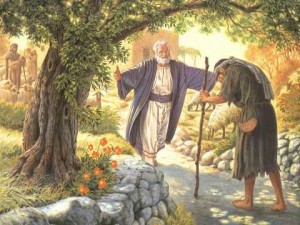
Prodigal Son: Luke 15:11-32
The Parable of the Prodigal Son is one of the few stories Jesus tells with more than 2 major characters. The father, older son, and younger son all have speaking parts, giving readers multiple characters to identify with. As you read this story try asking yourself, do I feel more like the younger son who has sinned against someone and needs forgiveness? Do I feel more like the older son who does what he’s told but never gets the credit? Or do I feel more like the father, serving as a peace-maker in a dysfunctional family? In other parables it’s obvious who were supposed to imitate (e.g. the Good Samaritan, the seed that falls on good ground), but this one isn’t as clear-cut. That’s because Jesus uses this one story to address multiple situations and appeal to different kinds of people all at once, and the character you identify with will determine what message you take away from the story.
Many of us have gone astray and need forgiveness from the ones we’ve hurt. We identify with the younger son, and we need to emulate his humility, returning to the one we’ve hurt and vowing to do whatever it takes to repair the relationship. Others of us know what it’s like to watch two of our relatives or friends fight with one another and become estranged. We identify with the father, and we need to show patience with both parties, offering compassion to both and inviting both to make amends with one another. Still others of us feel like we always (or usually) do what is right but never get our just reward, while others misbehave and go unpunished. We identify with the older son, and we need to listen to the father’s advice, receiving back those who were lost and reconciling with them. Also notice where this story ends. There is no conclusion; the older son remains out in the field pondering the advice his father has given him. Will he go inside and join his family? We the readers must finish the story, choosing love and reconciliation over self-righteousness.
Repetition also plays an important role in this parable. When the younger son returns home, he delivers the speech he’s been practice almost verbatim – almost. While working on another man’s farm, he decides to head back to his father’ estate and tell him, “Father, I have sinned against heaven and against you. I no longer deserve to be called you son; treat me as you would treat one of your hired workers.” But when he arrives home and greets his father, he says everything but the last part. Repetition is an important technique in Scripture, and what’s not repeated is also significant. Here the last part about being treated like a hired worker has been omitted. Perhaps the younger son is too emotional or too reluctant to go back to work as a hired hand, but more likely the father cuts him off, so overcome with joy at seeing his son that he doesn’t care about anything else. He has heard enough to know that his son’s apology is sincere, and he wastes no time in celebrating their reunion. Look also at the end of the story when the father and older son discuss the younger’s son behavior. Two things are noteworthy here. First, the older son complains to his father, “This son of yours swallowed up your property with prostitutes…,” and the father imitates the same wording in his response, “This brother of yours was dead and has come to life again….” They are all family, and the father repeats the formula used by his older son to emphasize the bond that all three men share. Second, notice where the older son is. He is “out in the field” (verse 25) at a considerable distance from his father so that he has to come out to speak to his son. His younger brother was also “out in the field” (verse 15) at a considerable distance from his father, and he came out to speak to his son. The parallelism puts the two brothers on a more equal footing, emphasizing the undue pride of the older son and the equal treatment of both by their father.
Looking at the context of this story also sheds light on its meaning. The Parable of the Prodigal Son is the third consecutive parable Jesus tells in this chapter. The Parable of the Lost Sheep (15:1-7) and the Parable of the Lost Coin (15:8-10) both precede it. All three parables have a common theme: recovering what was lost and rejoicing over it. A man leaves behind 99 obedient sheep to regain the one who went astray, and a woman sweeps her entire house to find the one coin she lost even though she still has nine in her possession. The point is that no person is too trivial or too sinful to ignore; everyone matters in God’s eyes. This common theme helps us appreciate what the story about the Prodigal Son is not trying to do. It is not trying to give us the whole picture when it comes to forgiveness, penance, and reconciliation; it only covers part of that process. Many readers struggle with the father’s unconditional reception of the younger son. All the young man does is admit he has sinned against his father and express his humility by saying he no longer deserves to be called his son. That’s a great start, but shouldn’t he also do penance by making up for the wrong he has done, like performing extra work on his father’s estate until he has paid off his debt? The younger son’s willingness to serve as a hired worker implies that penance is the proper thing to do here, even though he never carries it out in the story. Does Jesus really expect us to let bygones be bygones and forgive someone for a terrible wrong they’ve committed against us, no strings attached?
Those are valid questions, but they’re not the focal point of the story. Remember this parable has an incomplete ending. We want the older son to go inside and celebrate with his family, but we should also expect that on the next day, the celebration has ended and it’s time for people to resume their daily lives. The younger son should now atone for his sins by working to recover his lost share of the estate and rebuild the trust of his father and brother. However, Jesus can only accomplish so much with one parable! Jesus is merely trying to emphasize the importance of receiving back the lost. The hard work of rebuilding severed relationships will follow next, and it will take some time. For now, Jesus is hammering home an important message that is hard for us to accept. By telling these three parables in a row about recovering and rejoicing over the lost, Jesus teaches us about the loving forgiveness of God and encourages us to be selfless in our love for others. We must welcome everyone back with great joy no matter how much they’ve sinned.
But we can expand the context even wider than this chapter. By drawing on the technique of intertextuality, we’ll recall a similar story in Genesis 25-33 where two sons are at odds with one another and later reconcile. There once was a man who had two sons named Esau and Jacob. The two boys often fought and competed with one another until one day the younger son ran off to a faraway land with his father’s blessing. At the heart of their conflict was the share of their father’s estate which each stood to inherit, and Esau was deeply upset at Jacob for his scheming behind the scenes to get more than he deserved, which also created tension between Esau and his father. Eventually Jacob heads back home, and he is encountered by his brother Esau, whom he assumes is still furious at him. After all, Esau had threatened to kill him earlier!
So how does the story end? The two brothers reconcile, putting aside their differences and offering to do whatever they can to help each other. The older brother Esau even runs up to his brother, weeps over his neck, and kisses him, just like the father in the Parable of the Prodigal Son. The similarities are so strong that it becomes clear that Luke intended his readers to read this parable in light of the Jacob and Esau story from Genesis. Despite all the wrong that Jacob did to Esau, his older brother forgave him, setting a perfect example for the older son in Luke 15 and for us as well. We must learn to put the past behind us and receive back the lost with abundant joy, just as our heavenly Father does.
Learn more about practicing this method on your own.
